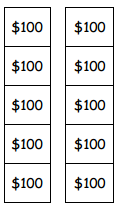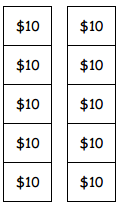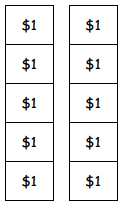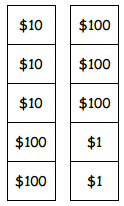Number lines are the important topics in maths. This will be helpful in the real-time environment. Know-how and where to apply the formulas from this page. Get a detailed explanation for all the questions here. Download Eureka Math Answers Grade 2 chapter 9 pdf for free of cost. As per your convenience, we have provided the solutions in pdf format so that you can prepare offline.
Engage NY Eureka Math 2nd Grade Module 3 Lesson 9 Answer Key
Get the guided notes for chapter 9 Answer Key from here. This will be the best resource to enhance your math skills. The topics covered in this chapter are number lines. test yourself by solving questions given at the end of the chapter.
Eureka Math Grade 2 Module 3 Lesson 9 Problem Set Answer Key
First, model the count using ones, tens, and hundreds on your place value chart. Then, record your count on the empty number line.
Empty Number Lines
Question 1.
70 to 300
![]()
Answer:
300 – 70 = 230.
Explanation:
In the above-given question,
given that,
model the count using ones, tens, and hundreds.
230.
2 x 100 = 200.
3 x 10 = 30.
200 + 30 = 230.

Question 2.
300 to 450
![]()
Answer:
450 – 300 = 150.
Explanation:
In the above-given question,
given that,
model the count using ones, tens, and hundreds.
150.
1 x 100 = 100.
5 x 10 = 50.
100 + 50 = 150.

Question 3.
160 to 700
![]()
Answer:
700 – 160 = 540.
Explanation:
In the above-given question,
given that,
model the count using ones, tens, and hundreds.
540.
5 x 100 = 500.
4 x 10 = 40.
500 + 40 = 540.

Question 4.
700 to 870
![]()
Answer:
870 – 700 = 170.
Explanation:
In the above-given question,
given that,
model the count using ones, tens, and hundreds.
170.
1 x 100 = 100.
7 x 10 = 70.
100 + 70 = 170.

Question 5.
68 to 200
![]()
Answer:
200 – 68 = 132.
Explanation:
In the above-given question,
given that,
model the count using ones, tens, and hundreds.
132.
1 x 100 = 100.
3 x 10 = 30.
2 x 1 = 2.
100 + 30 + 2 = 132.

Question 6.
200 to 425
![]()
Answer:
425 – 200 = 175.
Explanation:
In the above-given question,
given that,
model the count using ones, tens, and hundreds.
175.
1 x 100 = 100.
7 x 10 = 70.
5 x 1 = 5.
100 + 70 + 5 = 175.

Question 7.
486 to 700
![]()
Answer:
700 – 486 = 214.
Explanation:
In the above-given question,
given that,
model the count using ones, tens, and hundreds.
214.
2 x 100 = 200.
1 x 10 = 10.
4 x 1 = 4.
200 + 10 + 4 = 214.

Question 8.
700 to 982
![]()
Answer:
982 – 700 = 282.
Explanation:
In the above-given question,
given that,
model the count using ones, tens, and hundreds.
282.
2 x 100 = 200.
8 x 10 = 80.
2 x 1 = 2.
200 + 80 + 2 = 282.

Eureka Math Grade 2 Module 3 Lesson 9 Exit Ticket Answer Key
Question 1.
Jeremy counted from $280 to $435. Use the number line to show a way that Jeremy could have used ones, tens, and hundreds to count.
![]()
Answer:
435 – 280 = 155.
Explanation:
In the above-given question,
given that,
model the count using ones, tens, and hundreds.
155.
1 x 100 = 100.
5 x 10 = 50.
5 x 1 = 5.
100 + 50 + 5 = 155.

Question 2.
Use the number line to show another way that Jeremy could have counted from $280 to $435.
![]()
Answer:
435 – 280 = 155.
Explanation:
In the above-given question,
given that,
model the count using ones, tens, and hundreds.
155.
1 x 100 = 100.
5 x 10 = 50.
5 x 1 = 5.
100 + 50 + 5 = 155.

Question 3.
Use the number line to show how many hundreds, tens, and ones you use when you count from $776 to $900.
![]()
To count from $776 to $900, I used __1__ hundreds _2___tens __4__ones.
Answer:
900 – 776 = 124.
Explanation:
In the above-given question,
given that,
model the count using ones, tens, and hundreds.
124.
1 x 100 = 100.
2 x 10 = 20.
4 x 1 = 4.
100 + 20 + 4 = 124.

Eureka Math Grade 2 Module 3 Lesson 9 Homework Answer Key
Question 1.
Write the total amount of money shown in each group.
a.

Answer:
The total amount of money in the group = $1000.
Explanation:
In the above-given question,
given that,
there are 10 100 – dollar bills.
10 x 100 = 1000.
so the total amount of money in the group = $1000.
b.

Answer:
The total amount of money in the group = $100.
Explanation:
In the above-given question,
given that,
there are 10 10 – dollar bills.
10 x 10 = 100.
so the total amount of money in the group = $100.
c.

Answer:
The total amount of money in the group = $10.
Explanation:
In the above-given question,
given that,
there are 10 1 – dollar bills.
10 x 1 = 10.
so the total amount of money in the group = $10.
d.

Answer:
The total amount of money in the group = $532.
Explanation:
In the above-given question,
given that,
there are 5 100 – dollar bills.
3 10-dollar bills.
2 1-dollar bills.
5 x 100 = 500.
3 x 10 = 30.
1 x 2 = 2.
500 + 30 + 2 = 532.
so the total amount of money in the group = $532.
Question 2.
Show one way to count from $82 to $512.
Answer:
512 – 82 = 430.
Explanation:
In the above-given question,
given that,
model the count using ones, tens, and hundreds.
430.
4 x 100 = 400.
3 x 10 = 30.
0 x 1 = 0.
400 + 30 + 0 = 430.
Question 3.
Use each number line to show a different way to count from $580 to $994.

Answer:
994 – 580 = 414.
Explanation:
In the above-given question,
given that,
model the count using ones, tens, and hundreds.
414.
4 x 100 = 400.
1 x 10 = 10.
4 x 1 = 4.
400 + 10 + 4 = 414.

Question 4.
Draw and solve.
Julia wants a bike that costs $75. She needs to save $25 more to have enough money to buy it. How much money does Julia already have?
Julia already has $__100_________.
Answer:
The money Julia already has = $100.
Explanation:
In the above-given question,
given that,
Julia wants a bike that costs $75.
she needs to save $25 more to have enough money to buy it.
100 – 75 = 25.
25 + 75 = 100.
so the money Julia already has = $100.
